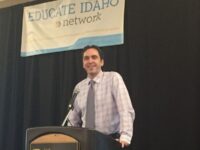Top state education researchers believe progress toward Idaho’s 60 percent college completion goal is being slowed by graduates pursuing higher paying jobs out of state.
“Students leaving the state is definitely affecting the number of graduates we are seeing here,” said Carson Howell, the State Board of Education director of research.

Nevertheless, Idaho is still well short of reaching its signature education goal to see 60 percent of its 25- to 34-year-olds hold some sort of college degree or certificate by the 2020 deadline.
Nearly 30 college and state university representatives gathered at Eastern Idaho Technical College in Idaho Falls Wednesday to hear Howell present college completion numbers to the State Board of Education.
The presentation was part of the board’s two-day stop in Idaho Falls.
State superintendent and board member Sherri Ybarra asked Howell how the state stacks up against the rest of the nation in terms of college completion.
“We are lower,” Howell said, pointing to the roughly 34 percent of Idahoans carrying an associate degree or higher, compared to a nationwide rate of nearly 43 percent.
Howell also pointed out increases in indicators driving college completion during the meeting. Roughly 37 percent of 25- to 34-year-olds held a postsecondary certificate or higher in Idaho in 2010, he said. That number climbed to nearly 40 percent in 2014 – still 20 percentage points away from where the state wants to be by 2020.
Increases in the number of students taking dual enrollment courses have also contributed to the minor uptick in college completion numbers. Just over 30,000 students took dual enrollment courses in 2008. That number more than tripled by 2015, with over 90,000 students participating in the courses.
Roughly 71 percent of Idaho students taking dual credit courses go on to enroll in college, Howell said. Those students also have a higher chance of completing degrees, with nearly 77 percent still enrolled after their first year. Approximately 63 percent of students without prior dual enrollment coursework return to college after year one.
Retention at the state’s major four-year institutions is also up. State colleges and universities retained around 69 percent of students in 2011. That number climbed steadily to just under 75 percent by 2015.
Degree production itself is also up from 2010, Howell reported, with bachelor’s degrees alone rising from 5,506 in 2010 to 6,870 in 2015.
So why the slow college completion growth?
Howell pointed to a chart comparing the salaries of recent graduates in Idaho, Washington and Oregon. Students entering the workforce in those states enjoy higher pay after graduation, including $2,000 more in the third quarter of their first year of employment.
The state also has problems retaining STEM graduates migrating to larger out-of-state tech firms like Microsoft in Washington, Howell said.
Roughly 25 percent of students with advanced STEM degrees were found working in Washington approximately one year after graduating in 2012. Roughly 12 percent of STEM students with bachelor’s degrees from Idaho institutions were found in Washington that same year.
Self-employed graduates, those working in ecclesiastical fields and some farmers weren’t included in the study, Howell said, leaving roughly 10 percent of recent graduates unaccounted for.
In order to count toward reaching the 60 percent goal, young adults must remain living in Idaho.
Howell also said the 25- to 34-year age range of graduates being measured by the board makes it difficult to see the growth in terms of college completion.
“Many of the students graduating with associate degrees or other certificates are younger than 25,” he said, “so we have to wait for them to hit 25 before we can include them in the study.”
In April, Idaho Education News reported that another annual report casts doubt on the prospect of reaching 60 percent by 2020. In 2014, 37.7 percent of Idaho’s adults held a postsecondary degree or certificate, according to an annual report on college completion rates by the Lumina Foundation. The national completion rate was 45.3 percent in 2014.
In other action during this week’s meetings, the board:
- Unanimously approved new standards governing bullying harassment and intimidation, including professional development for staff and “graduated” consequences and intervention for those who engage in bullying activity.
- Unanimously approved a variety of standards governing buses and operations for charter schools and districts.
- Unanimously approved changes to standards for initial certification of professional school personnel.
